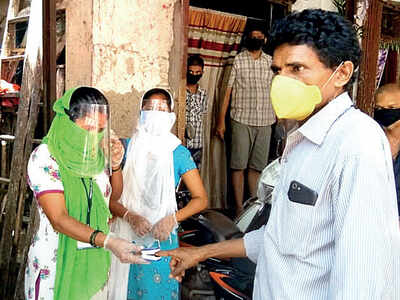
BMC to once again test asymptomatic contacts for COVID-19
by Linah BaligaCivic body changes testing protocol again; will aggressively trace all high-risk contacts of patients, even those asymptomatic, especially in slums
The civic body has a new slogan to tackle coronavirus - ‘Chase the virus, don’t shy away from it’. This was communicated to all ward officers by BMC chief Iqbal Chahal over video conference on Monday. What this means is that all high-risk contacts, who were in close contact with positive patients, even if they are asymptomatic, will now be tested, especially in slums.
In the meeting on Monday, Chahal instructed the assistant commissioners to aggressively detect positive cases to help contain the spread of the virus at the community level. This will also mean that there will be a surge in the number of reported positive cases, due to increased testing.
Click here for latest updates on the coronavirus pandemic
Manish Valanju, assistant commissioner, L ward, said, “The highrisk contact (HRC) ratio will be 1:10 where for every one positive patient, at least 10 people close to the patient will be institutionally quarantined and tested.
The spread is more in slums and so the focus will be on testing all high risk contacts between the fifth and 14th day.”
In the middle of April, the BMC had decided not to test high-risk contacts of positive patients, if they were asymptomatic. Instead, they would be sent to quarantine. The new civic chief has revised this protocol.
Prithiviraj Chauhan, assistant commissioner, M (west) ward said that the move to trace and isolate high-risk contacts will help prevent further spread of the virus in slums.

Even if a person is exposed to the virus, symptoms will develop based on the person’s immunity. So a person can develop symptoms after exposure to the virus much later and so the BMC will test between the fifth and 14th day.
Chauhan has alerted his staff comprising assistant medical officer, community health volunteers to trace HRCs. “Tracing and testing more high-risk contacts will have an advantage and we will start seeing the benefit of this exercise after eight days. The high-risk contacts will be in quarantine centres,” he said.
There are seven teams formed in M (west) ward comprising seven councillor wards with seven health posts. Each health post comprises medical officer of health (MOH), assistant MOH, health post staff, malaria investigators and community health volunteers (CHV) who do the job of contact tracing.
Chauhan said the whole job of contact tracing is dependent on CHVs also called Asha workers who go door-to-door and conduct surveillance. They used to earlier get paid Rs 9,000 but after the pandemic BMC doubled their salaries to Rs 18,000.
These Asha workers face many challenges as slum residents are often reluctant to be quarantined and refuse to go to isolation centres for 14 days. Picking up residents from slums and transporting them to quarantine and isolation centres is no easy task as some residents even turn violent and refuse to budge from their homes.
“The residents first react by saying that they are normal and have no symptoms. To convince them is a hassle for the workers. The Asha workers request them to cooperate and convince them that they will be kept in quarantine for 14 days for welfare of their own family. They are counselled before they are taken for isolation,” said Chauhan.